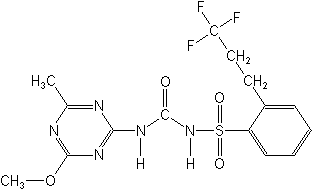-
Common NameProsulfuron
-
中文通用名氟磺隆
-
IUPAC1-(4-methoxy-6-methyl-1,3,5-triazin-2-yl)-3-[2-(3,3,3-trifluoropropyl)phenylsulfonyl]urea
-
CASN-[[(4-methoxy-6-methyl-1,3,5-triazin-2-yl)amino]carbonyl]-2-(3,3,3-trifluoropropyl)benzenesulfonamide
-
CAS No.94125-34-5
-
Molecular FormulaC15H16F3N5O4S
-
Molecular Structure
-
Category
-
ActivityHerbicide.Prosulfuron is most active when applied post-emergence on fully emerged weeds. However, pre-emergence applications control small-seeded weeds in moist conditions with residual activity lasting up to four weeks. Prosulfuron is absorbed by the roots and foliage of plants. Death occurs within three weeks of application. The label recommends the use of non-ionic surfactants or crop oil concentrates for optimum post-emergence activity.
In field trials, prosulfuron controlled triazine-resistant weeds. Generally, it does not interact with soil-applied insecticides. It showed good crop safety to maize and sorghum. When used with bromoxynil (300g ai/ha), good efficacy against weeds is shown at a dose rate of 15 g ai/ha. -
CropUseCropUses:
maize, wheat, sorghum
Maize
15-40 g ai/ha
-
PremixWater dispersible granules.
Premix Parters: captan; imazalil;Type
AI concn
Water-dispersible granule (WG)
75% (w/w)
57% (w/v)
-
Physical PropertiesMolecular weight:419.4; Physical form:Colourless, odourless crystals. Density:1.45 g/cm3 (20 °C); Melting point:155 °C ( decomp.); Vapour pressure:<3.5 ×10-3 mPa (25 °C) ( OECD 104); Henry constant:<3 × 10-4 Pa m3 mol-1; Partition coefficient(n-octanol and water):logP = 1.5 ( pH 5.0), -0.21 ( pH 6.9), -0.76 ( pH 9.0) (25 °C); pKa:3.76; Solubility:In distilled water 29 mg/l ( pH 4.5, 25 °C); in buffered water 87 ( pH 5.0), 4000 ( pH 6.8), 43 000 ( pH 7.7) (all in mg/l, 25 °C). In ethanol 8.4, acetone 1; Stability:Hydrolysed rapidly at pH 5, DT50 5-10 d (20 °C), very slowly at pH 7 and 9. Not degraded photolytically.
-
Toxicology(Rat): Oral LD50 4360 mg/kg b.w. Inhalation LC50 >5.14 mg/l air (4 h). (Rabbit): Dermal LD50 >2020 mg/kg b.w. Minimally irritating to eyes, non-irritating to skin.
-
Environmental ProfileEcotoxicology:
Algae: EC50 for Selenestrum capricornutum 0.011, Anabaena flos-aquae >0.027, Navicula pelliculosa >0.084, Skeletonema costatum >0.029 mg/l.Bees: LD50 (48 h) (oral and contact) >100µg/bee.Birds: LD50 for mallard ducks 1300, bobwhite quail >2150 mg/kg. Dietary LC50 (8 d) for mallard ducks and bobwhite quail >5000 ppm.Daphnia: LC50 (48 h) >120 mg/l.Fish: LC50 (96 h) for catfish, rainbow trout and carp >100, bluegill sunfish and sheepshead minnows >155 mg/l.Worms: LC50 (14 d) for earthworms >1000 mg/50 for mysid shrimp (Mysidopsis bahia) >150, Eastern oyster (Crassostrea virginica) >125 mg/l.Other beneficial spp.:No effect on rove beetle, ground beetle, aphid predator or ladybird, up to an application rate of 30 g/ha. No effect on respiration/nitrification.
Environmental fate:
Animals:90-95% Is excreted within 48 h. Main metabolic pathway is O-demethylation and side-chain hydroxylation.Soil: DT50 5-23 d, depending on temperature, soil moisture and % o.c.; DT90 30 to <100 d (typical value 60 d). Koc 4-41, depending on % o.c. Under practical condPlant:Main metabolic pathway is hydroxylation and cleavage of the phenyl and triazine ring systems. WATER SOLUBILITY: 29 mg/l at 25°C -
Transport InformationSignal Word:CAUTION; Hazard Class:III(Slightly hazardous)

 0
0 Subscribe
Subscribe
